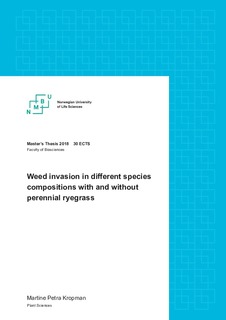| dc.description.abstract | Though perennial ryegrass (Lolium perenne) is a desired species in roughage production because of its nutritive qualities, it is not very persistent and - when used in species mixtures - often disappears after the first year. This may give weeds the chance to invade the space now left open. In this study, different species compositions - both including and excluding perennial ryegrass - were compared with each other as to their resilience to such an invasion, using data from both the first and the second year of ley. Additional factors of comparison were the inclusion of species with contrasting functional traits in the mixtures (fast-establishing vs. slowly establising and nitrogen fixing vs. nonfixing), the level of nitrogen fertilisation (moderate vs. low) and location (northern Norway (Holt) vs. the middle of the country (Kvithamar)). Yield levels were also analysed for all these factors.
Perennial ryegrass was found to have a weed suppressive effect, strongest in the first year, but still present in the second year, when the abundance of ryegrass was far lower. The effect of the presence of this species on yield levels, however, differed between the years: mixtures including perennial ryegrass had higher yields in the first year, but lower yields in the second year.
The presence of fast-establishing species in the mixture was found to have the main weed suppressive effect. Mixtures containing both fast-establing species and at least one nitrogen fixing species gave the highest yields; the mixture without any fast-establishing species gave the lowest yields.
The level of nitrogen fertilisation did not show any weed suppressive effect, though individual weed species may have been affected. The lower level of nitrogen fertilistation gave consistently lower yields.
Weed abundance was much higher at Holt than at Kvithamar. Yields were higher at Kvithamar than at Holt.
The point frequency method, a non-destructive way of estimating the biomass of different species in a plot usually used in natural vegetation, was evaluated for use in cultivated grassland. It provided results mostly agreeing with those obtained by harvesting and separating, though there were some limitations in the practicality of its use. | nb_NO |

